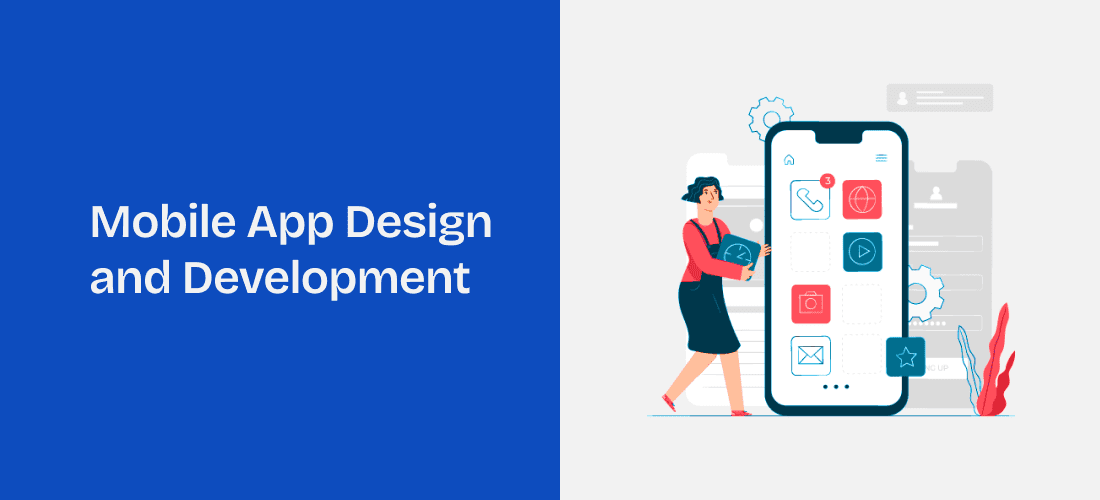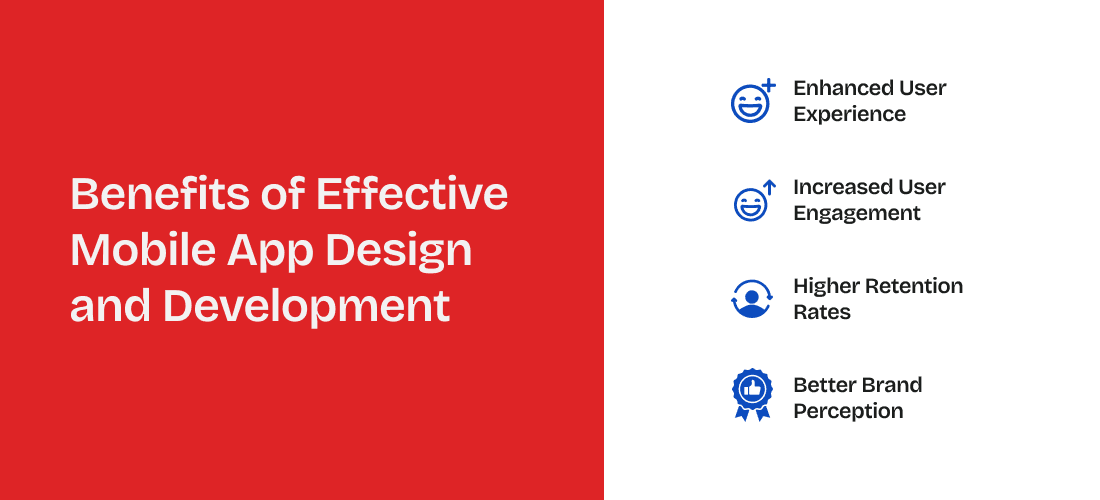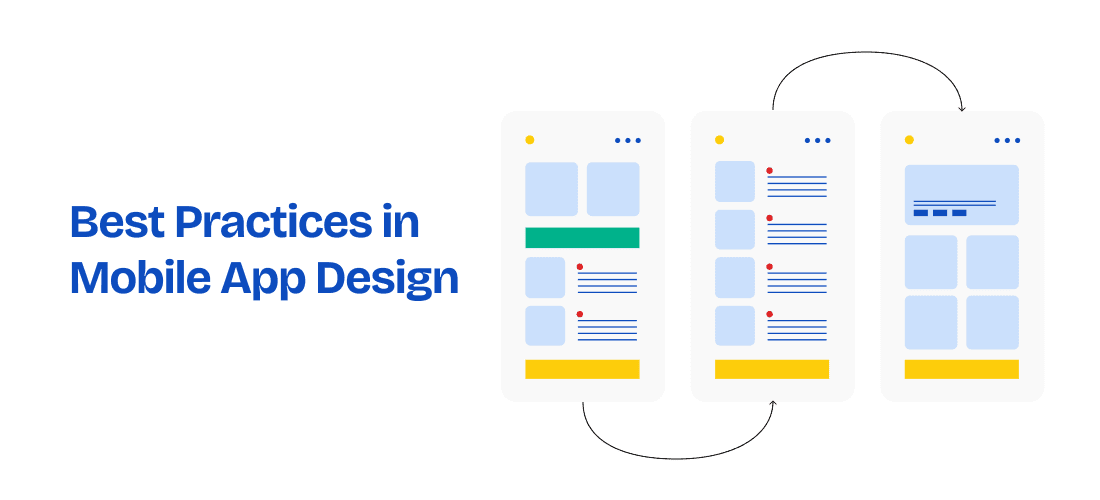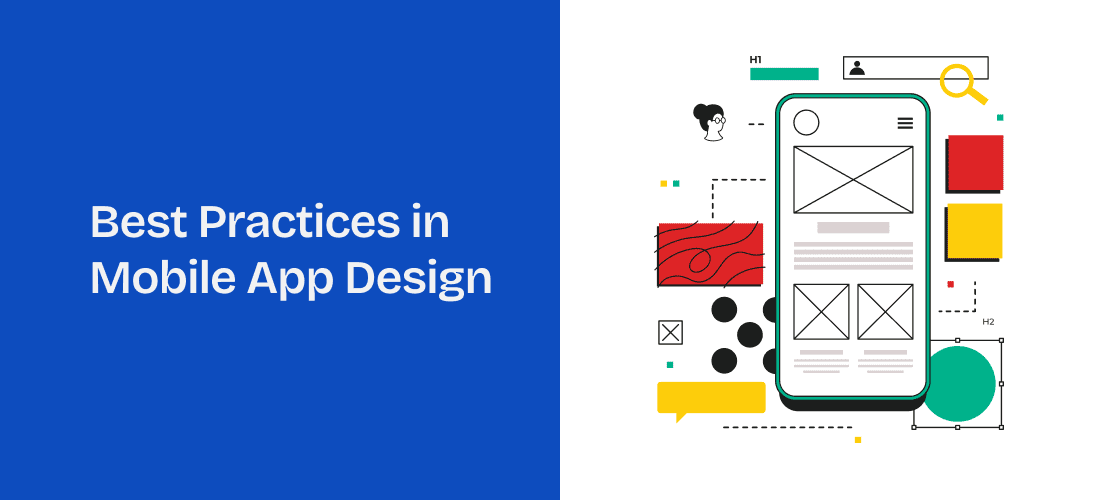Mobile apps have become an integral part of our daily lives. They offer convenience, entertainment, and functionality at our fingertips. As the number of mobile app users continues to grow, so does the competition in the app market. The success of any business hinges on standing out in the market which is why businesses must prioritize exceptional mobile app design and development. This involves more than just creating a visually appealing interface; it requires a deep understanding of user behavior, seamless functionality, and an intuitive user experience.
Here, we will discuss the essential best practices in mobile app design that every developer and designer should follow. From understanding user needs to incorporating the latest design trends, these practices will help you create an app that looks great and delivers a superior user experience.
Mobile App Design and Development

In an era where mobile devices dominate the digital landscape, the success of any mobile application hinges on its design. Whether you’re developing a new app or refining an existing one, effective mobile app design and development is crucial for delivering a seamless, engaging user experience. A well-designed app attracts new users while encouraging existing ones to stay engaged, ultimately driving business growth and customer loyalty.
Mobile app design and development is the process of creating software applications specifically designed for mobile devices, such as smartphones and tablets. It involves a combination of creativity, technical skills, and user-centric thinking to produce functional, visually appealing, and easy-to-use apps.
Key Components of Mobile App Design and Development
Here are the key components that build up the end-to-end mobile app design and development process:
- User Interface (UI) Design: This involves creating the visual elements of the app, including layouts, colors, typography, and icons. A well-designed UI makes the app visually appealing and intuitive to navigate.
- User Experience (UX) Design: UX focuses on the overall user journey and interaction with the app. It involves designing the app’s flow, navigation, and interaction patterns to ensure a seamless and enjoyable experience.
- Front-end Development: This involves building the visible part of the app that users interact with. It typically uses programming languages like HTML, CSS, and JavaScript, along with frameworks like React Native or Flutter.
- Back-end Development: This involves creating the server-side logic and data storage for the app. It often uses programming languages like Java, Python, or Ruby, and databases like MySQL or MongoDB.
- Testing and Debugging: This involves identifying and fixing errors or bugs in the app to ensure it functions correctly and provides a positive user experience.
- Deployment: This is the process of making the app available to users through app stores like the Apple App Store or Google Play Store.
Benefits of Effective Mobile App Design and Development

Every business worth its salt has a mobile application these days. Mobile applications make it easier for users to access services and make purchases. However, users don’t stick around unless the app itself is usable. Effective mobile app design and development ensures that any app developed will be user-friendly and keep users coming back. These benefits of effective mobile app design and development are:
- Enhanced User Experience: A well-designed app provides a smooth and intuitive user experience, making it easy for users to navigate and find what they need.
- Increased User Engagement: An engaging design keeps users interested and encourages them to spend more time in the app.
- Higher Retention Rates: Users return to an app that offers a positive experience, leading to higher retention rates and customer loyalty.
- Better Brand Perception: A polished and professional app design reflects positively on your brand, enhancing your reputation and credibility.
Best Practices in Mobile App Design

Creating a successful mobile app requires careful planning, user-centered design, and a focus on functionality. The following best practices in mobile app design will guide you through the process of developing an app that meets user needs and exceeds their expectations.
1. Prioritize User-Centered Design
User-centered design (UCD) is a design philosophy that places the needs, preferences, and behaviors of users at the forefront of the design process. The goal is to create an app that is intuitive, accessible, and enjoyable for the target audience.
Key Strategies:
- Conduct User Research: Before starting the design process, conduct thorough user research to understand your target audience. This includes surveys, interviews, and usability testing to gather insights into user needs, pain points, and preferences.
- Create User Personas: Develop detailed user personas that represent different segments of your target audience. These personas should include demographic information, goals, challenges, and behavioral patterns.
- Map User Journeys: Create user journey maps that outline the steps users take to achieve their goals within the app. This helps identify key touchpoints and potential pain points that need to be addressed in the design.
By focusing on user-centered design, you can create a mobile app that resonates with your audience and meets their expectations. This approach is fundamental to successful mobile app design and development.
2. Keep the Design Simple and Intuitive
Simplicity is a core principle of good mobile app design. Users should be able to navigate your app with ease, without being overwhelmed by unnecessary features or complex interfaces. An intuitive design ensures that users can quickly understand how to use the app, even if they are interacting with it for the first time.
Key Strategies:
- Streamline Navigation: Keep navigation simple and intuitive by using familiar patterns such as bottom navigation bars, hamburger menus, and swipe gestures. Limit the number of options in the menu to avoid overwhelming users.
- Use Clear Visual Hierarchy: Establish a clear visual hierarchy by organizing content in a way that guides users’ attention to the most important elements first. Use size, color, and spacing to differentiate between primary and secondary elements.
- Minimize Cognitive Load: Reduce cognitive load by minimizing the amount of information users need to process at once. Break down complex tasks into smaller, manageable steps and provide clear instructions.
A simple and intuitive design enhances usability and ensures that users can easily accomplish their goals within the app. This is a crucial aspect of mobile app design and development that should not be overlooked.
3. Focus on Consistency
Consistency in design is essential for creating a cohesive user experience. When users encounter consistent design elements, they can more easily understand and navigate the app, leading to a more enjoyable experience.
Key Strategies:
- Use a Consistent Visual Style: Maintain a consistent visual style across all screens and elements of the app. This includes color schemes, typography, button styles, and iconography.
- Establish Design Guidelines: Develop and follow design guidelines that outline the rules for using design elements consistently throughout the app. These guidelines should be shared with the entire development team to ensure uniformity.
- Ensure Functional Consistency: Ensure that similar actions and interactions have consistent outcomes across the app. For example, if swiping left deletes an item on one screen, it should perform the same action on all other screens.
Consistency is key to building user trust and ensuring a seamless experience across different parts of the app. It is a fundamental principle of effective mobile app design and development.
4. Optimize for Performance
Performance is a critical factor in mobile app design and development. An app that is slow to load, frequently crashes, or drains battery life will quickly frustrate users and lead to high abandonment rates. Ensuring that your app performs well on all devices is essential for user satisfaction.
Key Strategies:
- Optimize Load Times: Minimize load times by optimizing images, reducing the number of HTTP requests, and using efficient coding practices. Consider using lazy loading for images and content that are not immediately visible.
- Ensure Compatibility Across Devices: Test your app on a variety of devices, screen sizes, and operating systems to ensure it performs well across the board. Address any compatibility issues that arise during testing.
- Monitor and Optimize Battery Usage: Mobile apps that consume excessive battery power can be a major turnoff for users. Optimize battery usage by reducing background processes, minimizing data usage, and avoiding unnecessary animations.
By focusing on performance optimization, you can create a mobile app that runs smoothly and efficiently, providing a positive experience for users across different devices and environments.
5. Incorporate Responsive Design
With the wide variety of screen sizes and resolutions available on mobile devices, it’s essential to design your app to be responsive. Responsive design ensures that your app adapts seamlessly to different screen sizes, providing an optimal experience for all users.
Key Strategies:
- Use Flexible Layouts: Design flexible layouts that can adapt to different screen sizes and orientations. Avoid fixed-width elements and instead use percentage-based or relative sizing.
- Optimize for Both Portrait and Landscape Modes: Ensure that your app functions well in both portrait and landscape modes. Test your design in both orientations to identify any issues.
- Consider Accessibility: Make sure that your app is accessible to users with disabilities by following best practices for responsive design. This includes providing alternative text for images, ensuring sufficient color contrast, and enabling keyboard navigation.
Responsive design is a critical component of mobile app design and development, ensuring that your app delivers a consistent and enjoyable experience across all devices.
6. Leverage the Power of Microinteractions
Microinteractions are small, subtle animations or design elements that provide feedback to users as they interact with the app. These interactions play a significant role in enhancing the user experience by making the app feel more responsive and engaging.
Key Strategies:
- Provide Instant Feedback: Use microinteractions to provide immediate feedback for user actions, such as pressing a button, swiping, or completing a task. This helps users understand the result of their actions and creates a more interactive experience.
- Guide User Behavior: Use microinteractions to guide users through the app and highlight important elements or actions. For example, a subtle animation can draw attention to a new feature or prompt users to take a specific action.
- Add Personality to the App: Microinteractions can add personality and delight to the app, making it more memorable and enjoyable to use. For example, playful animations or sounds can enhance the overall user experience.
When used effectively, microinteractions can elevate the quality of your app and contribute to a more engaging and satisfying user experience.
7. Prioritize Security and Privacy
In today’s digital landscape, security and privacy are top concerns for users. Ensuring that your app is secure and respects user privacy is essential for building trust and maintaining a positive reputation.
Key Strategies:
- Implement Strong Authentication Methods: Use strong authentication methods, such as two-factor authentication (2FA), to protect user accounts from unauthorized access. Avoid storing sensitive information on the device.
- Encrypt Data: Encrypt sensitive data both in transit and at rest to protect it from unauthorized access or interception. Use secure protocols, such as HTTPS, for all data transmissions.
- Be Transparent About Data Usage: Clearly communicate how user data is collected, used, and stored. Provide users with the option to control their data and opt out of data collection if desired.
By prioritizing security and privacy in your mobile app design and development, you can build user trust and ensure compliance with data protection regulations.
8. Keep Up with Design Trends
The world of mobile app design is constantly evolving, with new trends and technologies emerging regularly. Staying up-to-date with the latest design trends can help you create a modern, relevant app that meets user expectations.
Key Strategies:
- Follow Industry Blogs and Publications: Keep up with the latest design trends and best practices by following industry blogs, publications, and thought leaders in the field of mobile app design and development.
- Experiment with New Technologies: Don’t be afraid to experiment with new technologies and design techniques, such as augmented reality (AR), voice interfaces, or AI-driven personalization.
- Stay User-Focused: While it’s important to stay current with design trends, always prioritize the needs and preferences of your users. Avoid adopting trends that may compromise the user experience.
By staying informed about the latest design trends, you can ensure that your app remains competitive and appealing to users.
Conclusion
Effective mobile app design and development is crucial for creating an app that not only looks great but also delivers a seamless and enjoyable user experience. By following the best practices outlined in this guide—such as prioritizing user-centered design, maintaining simplicity and consistency, optimizing for performance and responsiveness, and staying informed about design trends—you can create a mobile app that stands out in the crowded app market and meets the needs of your target audience.






